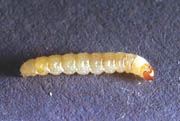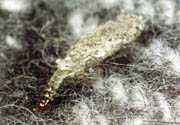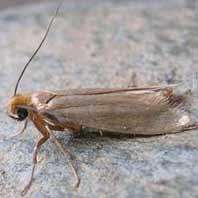 The casemaking cloth moth caterpillar (Tinea pellionella) loves to eat your dirty wool clothes, but these hungry insects eat other things too. A casemaking clothes moth caterpillar crawls around partly surrounded by its long, lumpy case. A caterpillar case (not the one in the picture) incorporates other protein and vitamin rich substances like hair, sweat and mineral salts from from sweat. In 2007 these hungry caterpillars helped identify a dead body near where they had been feasting. seems they had munched on some hair from the dead body which was then spun bits of the hair into its silken cocoon. these little bits of hair protein DNA helped identify a body Galveston County, Texas according to entomologist Sybil Bucheli of Sam Houston State University in Huntsville, Texas. This can help police identity a dead body, or help pinpoint where a person died
The casemaking cloth moth caterpillar (Tinea pellionella) loves to eat your dirty wool clothes, but these hungry insects eat other things too. A casemaking clothes moth caterpillar crawls around partly surrounded by its long, lumpy case. A caterpillar case (not the one in the picture) incorporates other protein and vitamin rich substances like hair, sweat and mineral salts from from sweat. In 2007 these hungry caterpillars helped identify a dead body near where they had been feasting. seems they had munched on some hair from the dead body which was then spun bits of the hair into its silken cocoon. these little bits of hair protein DNA helped identify a body Galveston County, Texas according to entomologist Sybil Bucheli of Sam Houston State University in Huntsville, Texas. This can help police identity a dead body, or help pinpoint where a person died
The life cycle of the clothes moth can last from two months to 2 yrs depending on temperature and food supply. The adults lay eggs on dirty wool clothing or other protein rich food source that the larvae will consume. Each female moth can lay from 100 to 150 eggs, which hatch in about five days.
rich food source that the larvae will consume. Each female moth can lay from 100 to 150 eggs, which hatch in about five days.
The small white caterpillars vary in size from 1/16 inch newly hatched to 1/3 inch fully grown. The caterpillar (larva) stage feeds on wool soon after egg hatch. Often they construct a silken tube and feed in the vicinity of this silken shelter. The larvae may continue to move across the fabric and only produce scattered patches of silk on which it rests. The larvae live in cases that are enlarged as they grow. When the larvae pupate, the case is transformed into a tough cocoon.
 The adult moth emerges from the pupal case in about 2 1/2 weeks. Mating and egg laying begins almost immediately emergence. Adult moths do not feed and die within a month.
The adult moth emerges from the pupal case in about 2 1/2 weeks. Mating and egg laying begins almost immediately emergence. Adult moths do not feed and die within a month.
In the heat of a home, development can occur continuously which produces overlapping generations. Development of clothes moths is slowed on clean wool. Sometimes they are unable to complete their development on completely clean wool, because the larvae require Vitamin B and various salts as essential nutrients, and these are lacking in completely cleaned wool. However, perspiration, and many other kinds of fabric soiling can provide vitamin B and salts. Clothes moth attacks are typically focused on such soiled patches of cloth.
Prevent holes in clothes
To keep your clothes from becoming “holey” good housekeeping is key. Clothes should be brushed and cleaned seasonally especially before stored. Storage containers, closets, dresser drawers should be cleaned well before woolen sweaters Remove woolen lint or hair from floors, shelves, and drawers and clean and inspect areas for the presence of clothes moths, such as attics, ventilation ducts, under beds and closets where insects and dust accumulate. Clothing bags, cedar closets, and cedar chests only provide protection when stored materials are free from infestation. Clean clothes and clean storage areas will prevent the finding the tell tale silk and the pelleted droppings the insect produces when it has made your clothes its home.
Resources
Clemson University/USDA Cooperative Extension Slide Series, http//: Bugwood.org
Cases of the casemaking clothes moth among woolen carpeting. (Photo by W. Cranshaw.)
Life History and Habits
http://www.sciencenewsforkids.org/articles/20081210/Note2.asp
Image 1 & 2 courtesy off Clemson University Extension
Adult image courtesy of

Leave a comment